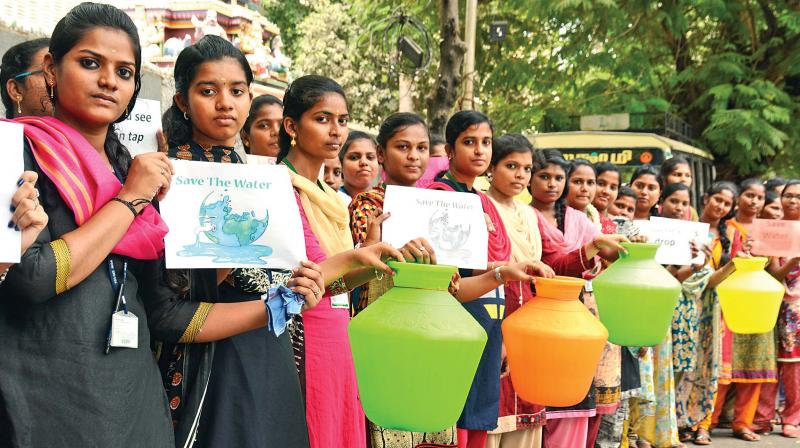Chennai: It’s battle for pot of water on every street

Chennai: The unprecedented water crisis in Chennai, worst in the last 10 years, has reached tenuous proportions with no signs of immediate relief from Nature. The Indian Meteorological Department (IMD) says that with the weakening of the severe cyclonic storm off Gujarat coast, conditions would be created for further advancement into other parts of the country of the southwest monsoon that hit Kerala coast a week later this year on June 8. But for North Tamil Nadu and Greater Chennai in particular, only a miracle can deliver.
As climate experts say the ‘Third World War’ would be over water among nation-states. What North Tamil Nadu is now witnessing in June 2019 seems a grim trailer of that frightful scenario; from the traditional row between Karnataka and Tamil Nadu over the release of Cauvery waters, the scramble for water within the state has trickled to inter-districts level. In Chennai, the battle for a pot of water is seen from ward-to-ward, street-to-street, particularly in its non-elitist underbelly.
The scenario is pathetic as women, elders and even children wake up at odd hours past midnight to fill few pots of water in most parts of Chennai. According to official sources, in the 15 zones of Chennai Corporation, water has to be reached to access points to 34,173 streets. It is a Herculean task.
The problems are quite different in urban middle and upper middle class localities where flat owners purchase water from faraway places from water tanker operators. Prizes per water tanker have zoomed to `4,000 to `5,000 now for a 12,000 litres capacity tanker. But even this quantity is not fully delivered with tanker operators offloading only up to 9,000 litres per trip, cries a city resident. Even as borewells have failed in many places in Chennai, despite drilling to deeper levels to tap the aquifer, one estimate puts the metropolitan’s current daily requirement of water at 1.10 crore litre per day. But what metro water has been able to provide now is only to the extent of 55.50 lakh litre per day. With this large demand-supply gap, market forces have taken over in pricing the water.
10,000 streets suffer
Anecdotal accounts in Chennai’s own lingo of ‘Kuzha Adi Sandai’ (street brawls at water taps) from the suffering people puts the level of water deprivation for at least 10,000 streets. Officials of Metro Water though say that they have been unable to reach water regularly only for 2,484 streets as they are in the interior parts where water tankers can hardly hope to enter. “But we are still making efforts even to reach those unreached so far,” says an official requesting anonymity.
In areas like Washermenpet, Vysarpadi, Perambur, which are among the worst hit areas, police are regulating the queues and rationing the available water at an average rate of four pots per family. But when larger families demand additional pots of water, it gives rise to squabbles.
The slum dwellers seem to be relatively luckier as they get priority in water distribution with politicos not wanting to anger them more or face their wrath with more road-rokos. It is the middle class localities that suffer more, forcing them to depend on water tankers, paying a premium for the water fetched.
‘Hoarding syndrome’ leads to attacks
In some places, the water scarcity has emboldened the ‘hoarding syndrome’, leading to even violent attacks in few places in the State. For example, in Vilar village in Thanjavur district and Manachanallur in Tiruchy district, two alleged hoarders of water, who built water socks for a week, were murdered.
In Anakaputhur on the outskirts of Chennai, a fracas over switching on the motor-pump in an apartment complex, when water level had hit rock-bottom in the area, one of the flat owners in a fit of rage attacked another woman resident as she resented his questioning of switching on the motor when there was no water. In Vellithirupur in Erode district, villagers stopped a TNSTC bus and forced all passengers to alight until local authorities made arrangements for water supply. Such incidents in recent days shows the extent to which mob psychology could descend in the wake of non-availability of something as elemental as water to meet people’s daily chores.
Chennai is supposed to get 12 tmcft of Krishna river water annually from Kandaleru reservoir in Andhra Pradesh. But this year till May 2019, only 1.98 tmcft of Krishna waters have been received at Poondi reservoir as there is not sufficient storage in Kandaleru reservoir to pump out the water into the Kandaleru-Poondi canal that transports the water to Chennai.
Under political pressure to augment water availability for the people of Chennai, Metro water now oversees the operation of 9,100 trips by 900 water tankers to ensure that water reaches the worst-affected parts of the city. The government is also mulling moving water through rail tankers from places like Vellore and using the Veeranam pipeline to bring water from NLC mines to the metropolis.
The Edappadi Palaniswami government has also chalked up other contingency plans to augment water supply which includes taking huge private farm wells on lease, pumping water from quarry lakes, and stepping up the outputs from the two sea water desalination plants at Minjur and Nemmeli.
The Tamil Nadu government has set apart Rs.233 crore for Chennai alone in this regard and another Rs.555 crore for areas outside Chennai. Another `43 crore is being tapped from the State Disaster Contingency Fund. All these, officials hope should help to meet minimum water needs of the people until the Northeast monsoon sets in November, said an official.

